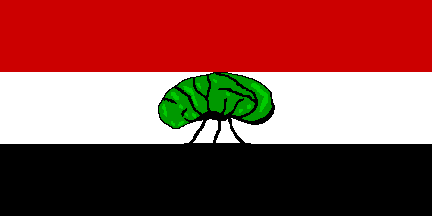 Image by Jorge Candeias,
29 Dec 1999 (2nd variant)
Image by Jorge Candeias,
29 Dec 1999 (2nd variant)

Last modified: 2018-06-12 by bruce berry
Keywords: oromiya | oromo | ethiopia | tree | star |
Links: FOTW homepage |
search |
disclaimer and copyright |
write us |
mirrors
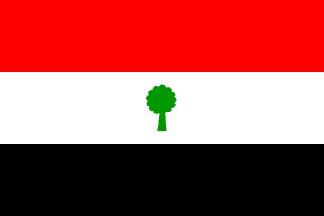 Image by Jaume Ollé, 22 Oct 1999 (1st variant)
Image by Jaume Ollé, 22 Oct 1999 (1st variant)
 Image by Jorge Candeias,
29 Dec 1999 (2nd variant)
Image by Jorge Candeias,
29 Dec 1999 (2nd variant)
See also:
[Both the terms "Oromiya" and "Oromia" seem to be used - Ed.]
According to the Ethiopian Parliament
website, Oromia is the largest of the newly demarcated states. It "comprises of 12 administrative
zones and 180 woredas. Of the 12 zones, Bale and Borena account for 45.7% of the
state's total area but only about 14% of the state's population. The
State of Oromia borders Afar, Amhara and the State of
Benshangul/Gumuz in
the north, Kenya in the south, the State of
Somali in the east, the
Republic of the Sudan and the State of Benishangul/Gumuz in the west, the
States of Southern Nations, Nationalities and Peoples' and
Gambella in the south. It completely surrounds
Harari State in the north east. Based on the political map (1994 Population and
Housing Census Commission, CSA), the estimated area of the State of Oromia
is about 353,690 km2 and it accounts for almost 32% of the land area
of the country. The
capital is Finfine (part of Addis Ababa)".
Jorge Candeias, 29 Dec 1999
The image of the first variant shown above is according to Flagmaster nr. 93 (Spring 1999) [fLm]. Reports vary on the flag's ratio and shape of the tree (according to a report from Jaume Ollé, 1999).
The flag is very similar to the image posted by Jaume Olle,
being
a red-white-black
horizontal tricolour with a tree emblem in the center (2nd variant illustrated
above). According to image at the Ethiopian Parliament website, the tree
is less stylized and not entirely green. It is perhaps a specific tree, but
unfortunately there's no "flora" section in the website to confirm this.
Jorge Candeias, 29 Dec 1999
The tree represented on the Oromo is a sycamore, known
locally known as "oda". In the traditional "Gada" system, the "Gada"
officers meet under the tree before "Chafee" meetings (http://www.gumii.org/gada/understd.html).
Ivan
Sache, 04 Nov 2009
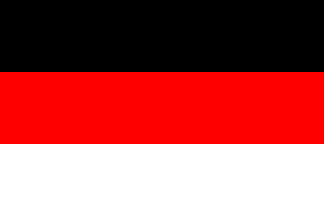 Image contributed by Tesfaye Gabriel, 27 Jan 1999
Image contributed by Tesfaye Gabriel, 27 Jan 1999
Before colonization, the Oromo nation had their own social, political and legal system. This system is called "Gadaa", and is a system that has guided the religious, social, political, economic, philosophical, art, history and method of time keeping of the Oromo people. In Gadaa system the Oromo society is grouped according to their age and undertake different responsibilities in different ages.
In Gadaa system, the Oromo practiced their own religion by worshipping Waaqa (which means God). Waaqa is one and the same for all. The religious affairs are undertaken by the Qaallu/Qaallitti (male/female) just like other religious leaders (such as a Bishop, Imam, Rabbi, etc). The Qaallu/Qaallitti play both a spiritual and political role in the Gadaa system where different national ceremonies are organized and overseen by Qaallu/Qaallitti institution. It was also a repository of important ceremonial articles or collective symbols like in the Buttaa ceremony, the bokku (scepter), the national flag, etc.
The local flag is made in the colours of the Qaallu turban (surri ruufa).
and has three equal stripes: black at the top, red in the center and white at the bottom. In the
Gadaa system, the three colours of black, red and white represent
those yet to enter active life, those in active life and those who had passed through
active life respectively - in short we can say the colours represent the past, current, and
the future.
Thanh-Tâm Lê, 11 Feb 1999
This flag is also shown on the chart Flags of Aspirant Peoples [eba94] (listed under nr. 24).
António MARTINS-Tuválkin, 29 May 2003
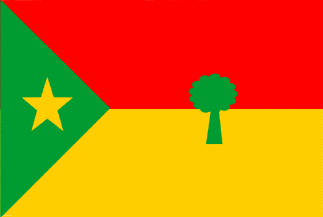 Image by
Jaume Ollé,
22 Oct 1999 (Source:
Flagmaster nr. 93
(Spring 1999) [fLm]).
Image by
Jaume Ollé,
22 Oct 1999 (Source:
Flagmaster nr. 93
(Spring 1999) [fLm]).
The ruling party in the Oromiya National Regional State is
the Oromo People's Democratic Organization (OPDO) or "Dhaabbata Demokraatawaa
Ummata Oromoo" (DhDUO) which was founded in 1989.
The OPDO is a member of the Ethiopian People's Revolutionary Democratic Front
(EPRDF). Together with the the Amhara National Democratic Movement, the
South Ethiopian Peoples' Democratic Front and the Tigrayan Peoples' Liberation
Front, the OPDO was founded in 1989 and superseded the Oromo Liberation Front as
the main ethnic Oromo party.
The flag of OPDO, as shown on their website,
is divided horizontally red over yellow with a green triangle placed along the
hoist and a tree in the middle.
Ivan
Sache, 04 Nov 2009
Oromo Liberation Front
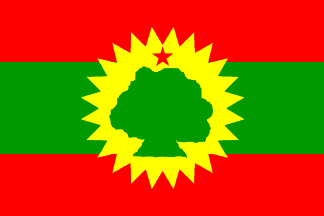 Image by António MARTINS-Tuválkin, 15 Oct 2017
Image by António MARTINS-Tuválkin, 15 Oct 2017
The Oromo Liberation
Front, an
armed Ethiopian movement struggling for independence of the Oromo people, has a
flag with three horizontal stripes of red, green and red. In the centre is a yellow rayed disc in
which is a green Oromo 'tree', above which is a small red 5-pointed star.
Giuseppe Bottasini, 24 June 1996
The flag of the Oromo Liberation Front, appeared in
Flagmaster No. 068 - 1991, p.7 [fLm]. This article gives the colour
symbolism of the flag.
The only actual colour meaning it gives is for the central yellow Sun. T he red star
would symbolize the left-wing political direction of this movement, I assume. It
also lists the then address of the Oromo Relief Association as 1 Amwell Street, London, EC1R 1UL, England,
UK.
This flag also appears as flag no. 24 on my flag chart,
Flags of Aspirant Peoples [eba94].
Ralph Bartlett, 20 Nov 2004
In 2009, the OLNF divided in two factions:
the Oromo Liberation Front - Qaama Ceehumsa (OLF-QC) and the Oromo Liberation Front - Shanee Gumii
(OLF-SG), both using
the same flag. In 2010 one of the factions created the Revolutionary
Democratic Oromo Liberation Front (RDOLF). The white over red could be the
unknown flag of RDOLF which joined ULFO on 07 March 2011. The OLF
didn't change its flags and the main faction is using now a red, green, red
flag.
ULFO was created in April 2010 by three movements:
1) Front for Independent Democratic Oromiyaa (FIDO)
which has a red, green, red flag with its
emblem in the centre;
2) United Oromo People’s Liberation Front (UOPLF) which has a black, red,
white flag with its emblem in the centre;
3) Council of Oromiyaa People’s Liberation Front (COPLF)
or Gumii adda
bilisimmaa ummata. Its flag has black, red and white
horizontal stripes.
The flag of ULFO has black, red and
white horizontal stripes.
An extensive article about flags of Afaria,
Gambella, Harar, Oromia and
Ogadenia will be published in Flag Report 72
(October
2014).
Jaume Ollé, 09 Sept 2014
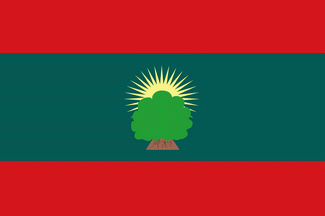 Image by
Valentin Poposki, 25 April 2007
Image by
Valentin Poposki, 25 April 2007
The Front for an Independent Democratic Oromia (FIDO) uses a flag
that is very similar to the
flag of Oromo Liberation Front. The FIDO
website describes its mission as:
"The central mission of FIDO is to utilize all necessary
means recognized by the United Nations General Assembly to
liberate the Oromia people from the political tyranny
and domination of Ethiopian government so that the
people of Oromia can exercise their inalienable right
for self-determination." The flag is also shown on their site.
Valentin Poposki, 25 April 2007